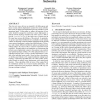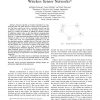1152 search results - page 167 / 231 » Communication management using abstraction in distributed ba... |
ECEH
2006
14 years 11 months ago
2006
: This paper presents the networking architecture developed in the CASCOM research project. This architecture provides an efficient and reliable communication support and service d...
MOBIHOC
2005
ACM
15 years 9 months ago
2005
ACM
Tiny, low-cost sensor devices are expected to be failure-prone and hence in many realistic deployment scenarios for sensor networks these nodes are deployed in higher than necessa...
CONCUR
2004
Springer
15 years 3 months ago
2004
Springer
Abstract. Discretionary Access Control (DAC) systems provide powerful mechanisms for resource management based on the selective distribution of capabilities to selected classes of ...
INFOCOM
2010
IEEE
14 years 8 months ago
2010
IEEE
— In opportunistic networks, end-to-end paths between two communicating nodes are rarely available. In such situations, the nodes might still copy and forward messages to nodes t...
110
click to vote
INFOCOM
2006
IEEE
15 years 3 months ago
2006
IEEE
Abstract— Sensors typically use wireless transmitters to communicate with each other. However, sensors may be located in a way that they cannot even form a connected network (e.g...



